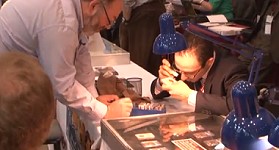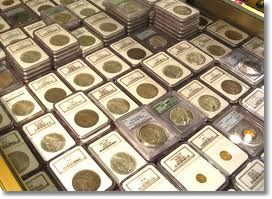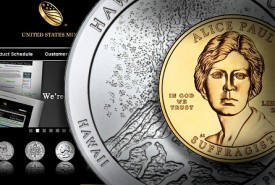by Louis Golino for CoinWeek ………
Three times a year Whitman Publishing sponsors the Whitman Expo in Baltimore, Maryland, an east coast city with a storied history that is known to locals as Charm City. The show is held at the modern convention center located around the corner from Camden Yards, the home of the Orioles, and near the famous inner harbor area.
Hundreds of dealers come from all over the country, and industry leaders like Teletrade, Stacks-Bowers, NGC, and PCGS, and some of the most well-known coin companies like Legend and Spectrum, are there too.
There is usually a major auction event held by Stacks-Bowers or another high-end auction company, meetings of several coin groups, a lecture, and other events.
This year’s summer show, which was held from June 20 to 23, included a talk on Saturday, June 22, by retired Coin World editor, Beth Deisher, whose new book on how to sell your coins, Cash in Your Coins: Selling the Rare Coins You’ve Inherited, is hot off the press, and the first copies were available at the show. Like so many Whitman books it is beautifully illustrated and packed with practical advice, especially for those who do not have a background in numismatics.
 The staff at the Whitman Publishing booth told me that an updated version of their ANA grading standards book (the last version came out in 2006) and the second edition of American Silver Eagles are coming soon and lots of other exciting titles.
The staff at the Whitman Publishing booth told me that an updated version of their ANA grading standards book (the last version came out in 2006) and the second edition of American Silver Eagles are coming soon and lots of other exciting titles.
I normally attend at least two of the Baltimore shows a year. In addition to the fact that Baltimore is a great place, especially during the summer, to spend a day away from home, I always enjoy talking coins with dealers and fellow collectors.
I also usually bring some submissions to drop off at NGC and PCGS for grading to save on shipping costs and reduce the amount of time until I receive my coins back from the grading companies. Some years on-site grading is done at the show, but at this Baltimore show the grading companies were only accepting submissions that will be graded at their headquarters.
During the spring show I left some coins with NGC grader and modern coin expert David Lange, who I enjoyed meeting. I was amazed to receive my coins back only about two weeks later.
The summer show is invariably the slowest of the three Baltimore shows. But for the past two years I have noticed a lot of dealers said they did rather brisk business, which is probably a sign of the overall health of the coin market. Plus the slower shows have the advantage of allowing more time for discussion, viewing displays, etc.
 One dealer I spoke with at the June show said he did a lot of business early in the day on Thursday and Friday morning when people who pay an early bird fee have access to dealers’ wares before the general public is allowed in. That is when the best and freshest coins are scooped up by serious collectors.
One dealer I spoke with at the June show said he did a lot of business early in the day on Thursday and Friday morning when people who pay an early bird fee have access to dealers’ wares before the general public is allowed in. That is when the best and freshest coins are scooped up by serious collectors.
This year’s summer show started on the day the precious metals market had their second major implosion of the year, with gold dropping $100 compared to the previous week, and silver dropping more than 10%. If you were looking to buy bullion, that was fortuitous timing, though many dealers do not bring a lot of bullion to such shows because of the added weight, the fact that it delays getting through airport security, and so forth.
Bullion sales were brisk early in the day Friday with buyers looking to take advantage of the major drop in prices. Many dealers sold out of popular bullion coins like American silver eagles, and by Friday afternoon gold bullion staples like American gold eagles were becoming harder to find. Bars were selling for almost the same premium as coins, and the coins seemed like a better deal to me.
Dealers obviously too a big hit on bullion-related items thanks to the over-reaction of the market to the highly predictable Fed statement saying the bond buying program would begin to be scaled back later this year provided the economy continues to improve.
One dealer seemed especially perturbed by the drop in bullion, remarking that “money is not everything” and talking about how he could not wait to retire after the carnage of the last two days. At one point he said he had lost $200,000 in the past day because of the drop in gold and silver prices. But then he pointed out that those were actually paper losses. Since he still had most of the coins, he had not actually lost all that money.
I asked a lot of dealers what was selling well, and as usual many remarked that better-quality type coins were hot.
Type coins are an interesting segment of the market as seen from the vantage point of a major American coin show. Most people sell high-end graded pieces, the kind of coins that only someone who earns a substantial income can afford. Then there is the ungraded stuff, which mostly looks dipped, not that attractive, or otherwise problematic, although there are some dealers with nice ungraded classic coins.
One dealer had cases of graded circulated Barber coins, but they were almost all on the low end of the grading scale and a major portion of them were details graded coins that were found to have some kind of issue. I looked in vain for a Barber quarter or half dollar of any year that graded XF or better and did not have issues. A barber quarter in mid-range uncirculated condition is not an expensive coin, but good luck finding one, especially at a coin show.
 And that is precisely the problem with trying to collect nice, but affordable classic type and related coins. There are coins that in theory would be great to add to one’s collection like a draped bust half dollar from the early 19th century in say fine that runs about $300, but they rarely show up in dealer inventories or coin shows. Instead high-grade examples like one I saw that a well-known dealer, Jack Beymer, had at the show that was $7,000 are displayed. And it makes me wonder who outside of very wealthy individuals has seven grand to spend on one coin?
And that is precisely the problem with trying to collect nice, but affordable classic type and related coins. There are coins that in theory would be great to add to one’s collection like a draped bust half dollar from the early 19th century in say fine that runs about $300, but they rarely show up in dealer inventories or coin shows. Instead high-grade examples like one I saw that a well-known dealer, Jack Beymer, had at the show that was $7,000 are displayed. And it makes me wonder who outside of very wealthy individuals has seven grand to spend on one coin?
And this raises what I view as the major area for improvement at shows like the Whitman Baltimore Expo. Modern coins are the fast-growing segment of numismatics, yet not a single mint, U.S. or foreign, normally has representation at the Baltimore show during the years when I have attended; other than bullion, few dealers bring substantial inventory of modern coins to the show; and the dearth of world coins, modern and classic, is breathtaking.
It never ceases to amaze me how when I attend the Baltimore show I see almost no First Spouse gold coins, America the Beautiful five-ounce coins, American platinum proof eagles, or anniversary sets of American silver eagles (apart from some graded coins) for sale. Those are the kinds of coins that people of more average means are buying, but when you walk the aisles at Baltimore, you would hardly know they exist.
One dealer asked me what I collected, and I said I leaned more towards modern coins though some classic coins also appeal to me, and he said, in words that echo what many of the kind of dealers who attend the Baltimore show have said: “I hate modern stuff.” One wonders, though, if he is really familiar with what the U.S. Mint is issuing these days, and why he hates it so much. I am not certain, but I suspect it has something to do with the fact that most major dealers are middle-aged men who grew up collecting older American coins.
There are also so many interesting vintage and modern world coins from all over the world that appeal to plenty of collectors, but only a handful of dealers have displays of such coins. I would have been interested, for example, in picking up an old British trade dollar, but I did not see any at the show. One dealer had some interesting French gold coins, but he could not quote me a price because the owner of the coins was in France.
I realize the Baltimore show is not the ANA’s World Fair of Money, which is a show that highlights the offerings of world mints, but I still feel that it would be possible to make the show more interesting by catering more to collectors of modern American coins and both classic and modern world coins.
Year after year I go and see endless stacks of graded Morgan and Peace dollars, high-end type coins, classic gold, etc. It’s time to shake things up a bit and make the show more worthwile for modern U.S. coin and world coin enthusiasts.
 Louis Golino is a coin collector and numismatic writer, whose articles on coins have appeared in Coin World, Numismatic News, and a number of different coin web sites. His column for CoinWeek, “The Coin Analyst,” covers U.S. and world coins and precious metals. He collects U.S. and European coins and is a member of the ANA, PCGS, NGC, and CAC. He has also worked for the U.S. Library of Congress and has been a syndicated columnist and news analyst on international affairs for a wide variety of newspapers and web sites.
Louis Golino is a coin collector and numismatic writer, whose articles on coins have appeared in Coin World, Numismatic News, and a number of different coin web sites. His column for CoinWeek, “The Coin Analyst,” covers U.S. and world coins and precious metals. He collects U.S. and European coins and is a member of the ANA, PCGS, NGC, and CAC. He has also worked for the U.S. Library of Congress and has been a syndicated columnist and news analyst on international affairs for a wide variety of newspapers and web sites.





But then he pointed out that those were actually paper losses. Since he still had most of the coins, he had not actually lost all that money.
I’ve heard other gold buyers mention this before. Broadly, it is correct that you don’t recognize the losses until you sell. However, if this dealer needs cash, he is going to be forced to take those losses. Let’s hope the price recovers before that happens (though to be honest, I think we have even more downside to come).
Year after year I go and see endless stacks of graded Morgan and Peace dollars, high-end type coins, classic gold, etc. It’s time to shake things up a bit and make the show more worthwile for modern U.S. coin and world coin enthusiasts.
Preach on, Louis! The problem with the Whitman show is that they sell the same stuff year after year there, with very little variety. It’s always just an endless sea of slabbed US coins from the 1850s-1950s. Most are considerably overpriced as well. There is one table in the whole of the place that reliably sells modern Perth Mint and RAM issues that I have been able to find. To be frank, a lot of what’s sold at Whitman just isn’t for me and I generally just go there more to browse than buy.
One dealer asked me what I collected, and I said I leaned more towards modern coins though some classic coins also appeal to me, and he said, in words that echo what many of the kind of dealers who attend the Baltimore show have said: “I hate modern stuff.” One wonders, though, if he is really familiar with what the U.S. Mint is issuing these days, and why he hates it so much.
I’ve heard the idea expressed before that modern coins are all “junk” and are not “real numismatic pieces.” Ultimately, I’ve come to look at coin collecting as being divided into sort of three segments – those who collect modern coins like us, those who assemble sets of historic coins, and the “big players” who trade in the truly rare pieces that can go for tens of thousands or more. The latter two often don’t seem to recognize collectors of modern coins as “real” collectors, which I think is silly. Just because a mint intentionally makes a rare coin with low mintages does not mean the coin is somehow “not rare.”
Thanks very much, Capt., for your insightful comments and for sharing your experiences. The one point on which I would push back gently is on the rarity issue.
While I of course agree that moderns are not junk, I do think there is a big difference between a scarce, low mintage modern coin (that big dealers have large supplies of in most cases) and rare classic coins (where, as I explained in my article, even a relatively inexpensive coin can be very hard to find). The point is rare classic coins are not readily available and are becoming harder and harder to find. That is why nice for the grade old type coins have been moving steadily up for decades.